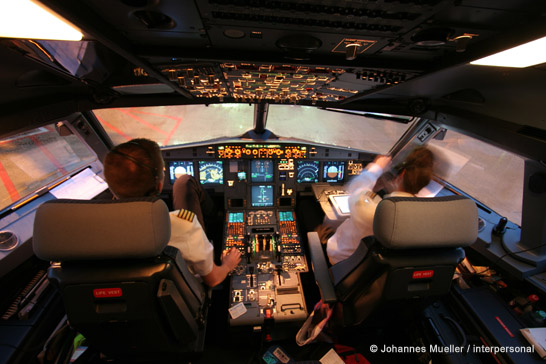
Air Transport Pilot (ATPL (A))
What does an Air Transport Pilot with ATPL (A) license do?
Air Transport Pilots with ATPL (A) navigate large cargo and passenger aircrafts which are flown by two pilots. The cockpit team consists of a more highly ranked Captain and the First Officer. Both are licensed pilots. The cabin crew are also under the control of the Captain. The tasks include preparation and completion of the flight as well as organisational tasks. A passenger aircraft pilot's activities range from checking the weather reports to precisely navigating the aircraft and creating the necessary reports.
Which requirements do air transport pilots with ATPL (A) license need to fulfill?
Air transport pilots require a valid ATPL (A) license. Additionally, your aero-medical suitability will be assessed prior to professional practice. Further requirements vary depending on the employer. These can include:
- Medical fitness
- Class or type rating of the respective aircraft types.
- Background check by the Federal Aviation Authority
- Fluent German and English
- University entrance exam or similar
- A physical size between 165cm and 198cm
- Good sight (critical values vary)
- Valid aeronautical radio certificate
How can I become a Air Transport Pilot with (A) license?
Die ATPL (A) license for air transport pilots can be obtained at flight schools which are either run privately or by affiliated airlines. To be admitted to a flight school, you need to pass several aptitude tests. Prospective air transport pilots learn the theoretical background in classes and practise flying in simulators. Besides the theoretical training, you will need to complete at least 195 flying hours, partly in simulators, by the end of the certification. The training period can be completed in full or part-time and depending on previous knowledge can be completed in seven to 24 months. The training to become a air transport pilot is not remunerated. In addition, trainee pilots need to bear the high training costs themselves, however there are often financing models which ease the accessibility.
The final examination consists of a theoretical and a practical part, however successfully completing the theory exam is a prerequisite to being admitted to the practical examination. During the practical examination, candidates must prove that they are capable of controlling the height, speed and course of the aircraft. The exams are taken at the German Federal Aviation Authority.
What can Air Transport Pilots with ATPL (A) license expect in professional life?
Air Transport Pilots are active in scheduled air services and charter flights or they fly employees and goods for companies with their own fleet of aircrafts. Pest control and patient transport are further potential tasks of commercial pilots. There are further occupations in the German Army, at flight schools, manufacturers for air- and space crafts or in research and development for the field of engineering sciences.
Air transport pilots need to be highly flexible as they need to work at night, on Sundays and public holidays. Work routines will constantly test your physical and psychological resilience. Dry atmosphere in the cabin, switching between time and climate zones, responsibility for human lives and power of concentration over a long period of time make the occupation of a passenger aircraft pilot very demanding. Furthermore, air transport pilots need to be team players, have a great command of English and keep up-to-date on the latest technical and legal developments in the market.
Proportionate to the strenuous training and high level of job responsibility, earning prospects for air transport pilots are great. However, salaries do vary from employer to employer. Gross average wages come to around 5,000 Euros and increase according to experience and length of company affiliation.